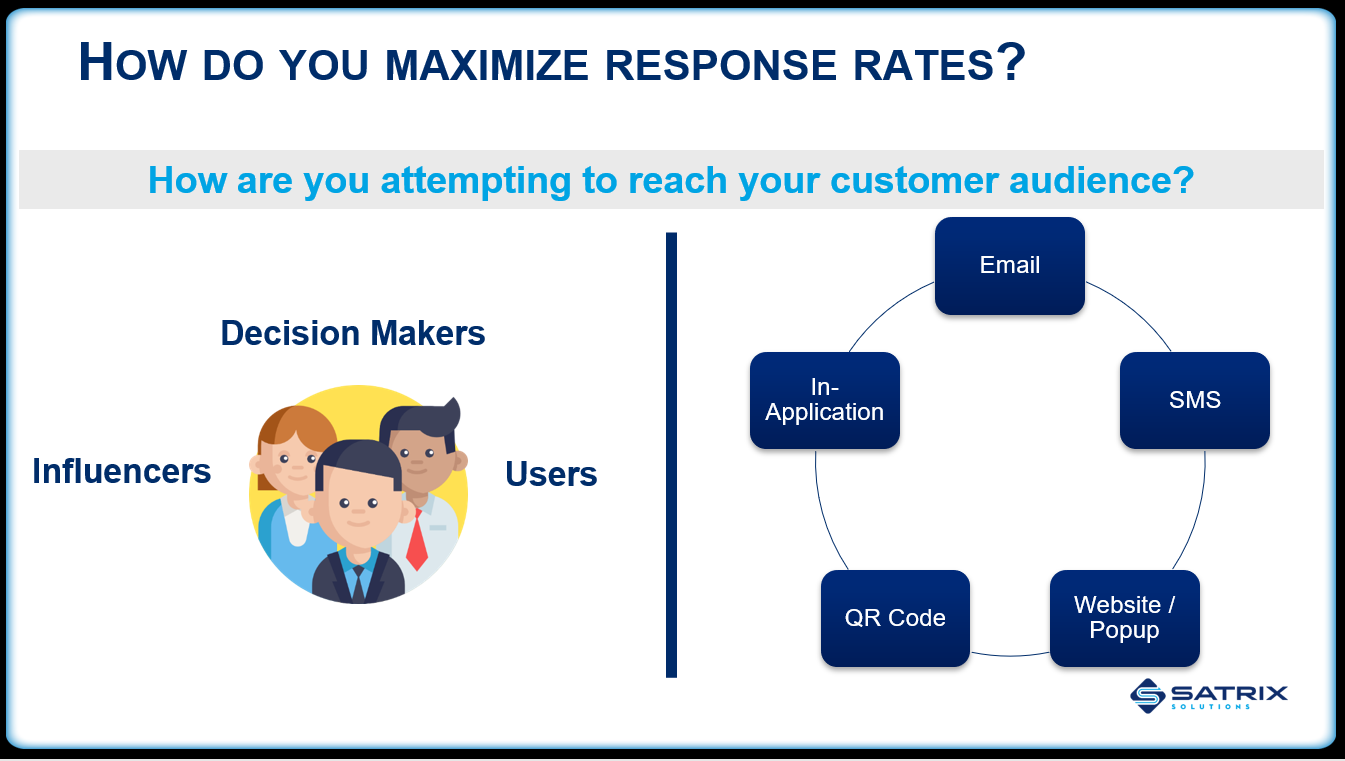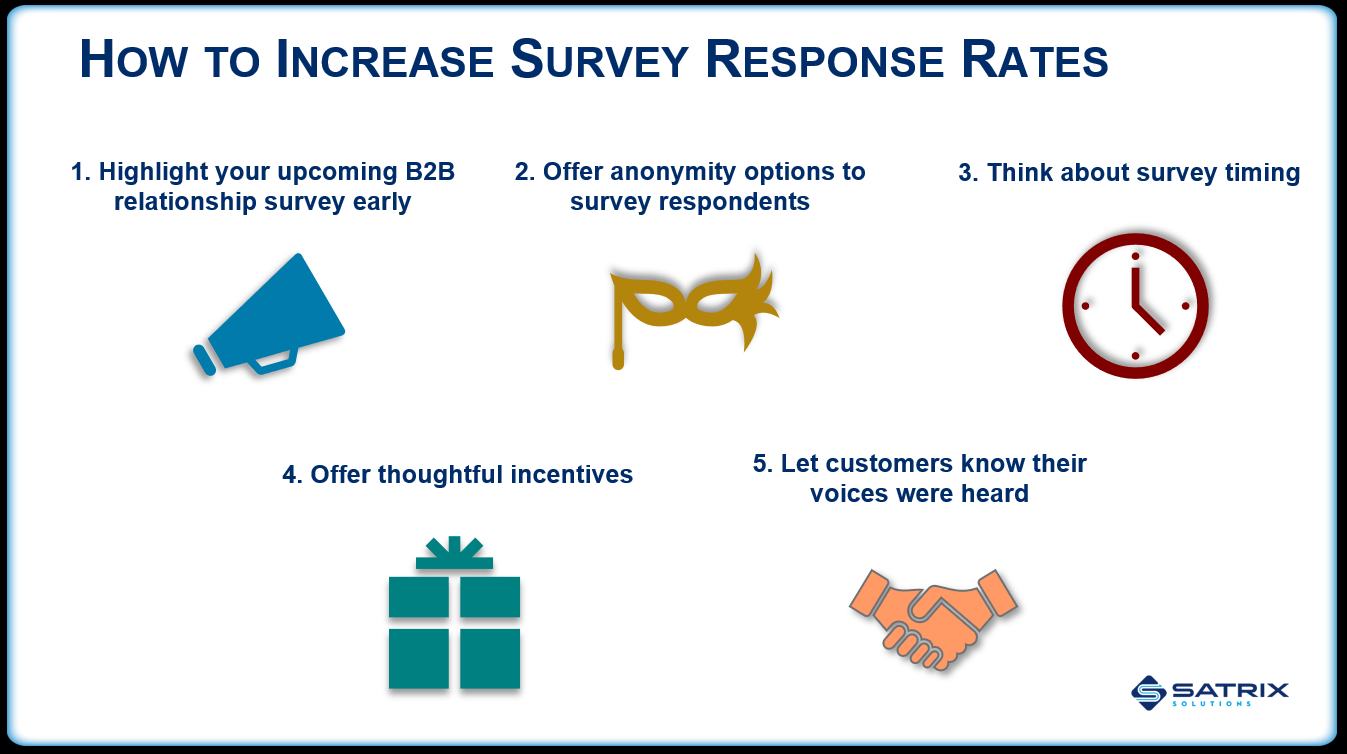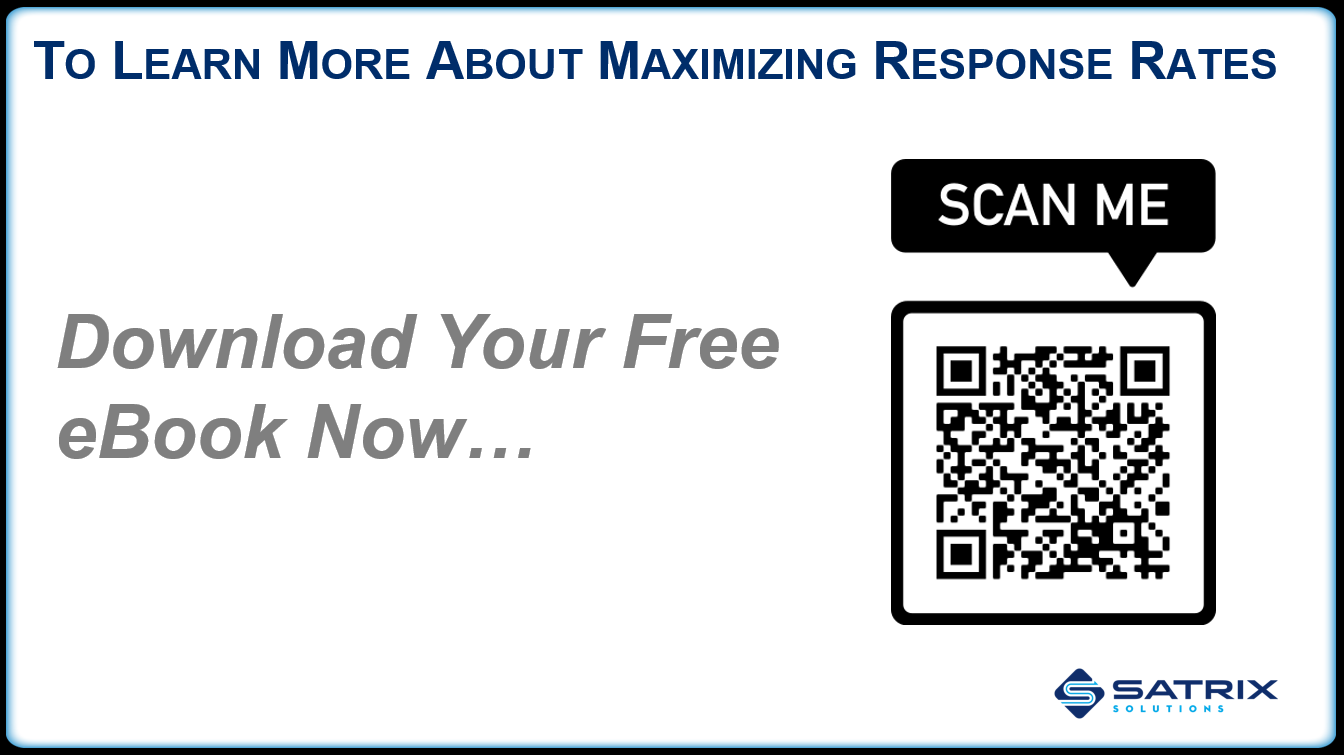As customer experience consultants for B2B companies, we’ve heard from many business leaders who have struggled to get customers to respond to their survey requests. This is problematic for many reasons. After all, how can you create the experiences which will establish advocates for your products and services if you don’t have feedback from your customers?
During this roundtable talk, Jonathan Beretta, VP of Client Service, and Christian Muma, Senior Director of Customer Insights, take on one of the biggest obstacles to collecting actionable data from online surveys – maximizing survey response rates.
Watch the video or read the transcript below:
Survey Distribution Methods
Jonathan Beretta:
One way to boost response rates is to ensure you’re reaching as many people as possible by utilizing more than one distribution method. So let’s talk about how do you distribute surveys in a multitude of ways and use those to help you boost response rates.
There’s a number of audiences or different personas that you’re going to reach out to. Decision-makers, who are those individuals that have the most say on whether or not to continue to engage with you. Influencers, who may be managers that are influencing decisions of which different organizations to utilize for products and services. And then, of course, the Users of your products or services and their experience with your product or service. For example, are you making their work more efficient or more productive?
We need to get all of that information in a cohesive way so when you have your annual or quarterly business reviews with your customers, you can discuss these aspects with them to show the value that you bring to them or the return on investment.
Let’s jump into this and we’ll start with the type of distribution of survey emails. Christian if you’d like to cover this one first.

Send Your Survey Via Email
Christian Muma:
Absolutely. Despite all the emerging technology and shifting landscapes, email is probably the most effective way of getting your survey out there. Some things that I’ve seen work really well in the past is good “from” lines.
In emails, are you using your CEO’s name or somebody that’s recognizable amongst your customers? Or are you using a generic “do not reply” inbox? Believe it or not, who you have on that “from” line does make a difference. If it is somebody recognizable, your open rates tend to increase.
Additionally, let’s look at the invitation itself. Is it readable? Or is it written prose with a lot of paragraphs and a lot of content for your potential respondents to sort through? Typically, short, sweet, and to the point works best.
Then there’s also thinking about your actual survey link. Many software platforms allow you to embed the first question or other questions of the survey right into the email. We have found that this has increased our response rates, not necessarily the number of completions but you do get more feedback upfront when you embed the survey question.
Jonathan, I think you’re best suited to talk about text messaging or SMS. I mean, you have a client that takes advantage of text message distributions, don’t you?
Send Your Survey Through Text
Jonathan Beretta:
Yes. One of our clients is a multinational, publicly-traded organization in the manufacturing / production area. They are using SMS for a voice of the employee program internally because they have many individuals that are out on job sites or places where email may not be readily available.
For those of you that may not know SMS is just simply mobile text messaging. And there are really two ways that you can do text messaging. You can write up a brief statement with a URL so that when they receive the text message, they click on the link, open up the survey in their mobile browser.
The other way is called two-way communication. And that’s where you send them the first question on the survey, they text back the answer and then they are text the next question in the survey. This can work great to allow people to complete it over time as they don’t have to complete it all at once.
The only downside is the additional cost if you have to pay for text messages in both directions for each question and response that you receive, but it offers a variety of methods for individuals that may not be in an office environment with regular email.
Christian for you, what about websites and pop-ups?
Add a Pop Up Survey to Your Website
Christian Muma:
Yeah, absolutely. Survey software platforms allow the ability to actually put a pop up on your website. So, depending on if potential respondent comes to a certain page, it’s an opportunity to survey them and it just pops up and they can respond to a question. It’s actually proven quite successful.
What I found that makes the feedback a little bit more meaningful is you have the ability to track where specifically in your website the pop-ups are coming up. Then you can start to segment, identify themes, you know, is there a certain sentiment that comes about when respondents are on a certain turn page versus somewhere else? So certainly, something to consider.
And then to the best of your ability, identifying the persona. So people taking the survey from a pop-up – are you still able to identify the Decision-makers from the Users? To your point, Jonathan, that you made, identifying these folks, top of the slide is important, if not adding in some demographic questions within the pop-up, could certainly be useful.
Jonathan, talk to us about the QR code.
Create a QR Code for Your Survey
Jonathan Beretta:
The QR code is an interesting one, as QR codes have been around for a long time and have not really been used or utilized as well as they could be.
But basically, it’s a graphic visualization of a web link. And you’ll see an example of this later in our talk today when we offer up our free ebook. You just point your cell phone’s camera to the QR code and it triggers the URL and takes them directly to the survey.
This is great if you need to put it up in certain areas. Maybe there’s transactional surveys when certain things are happening at different locations. We’ve used this for a couple of our clients in various areas, including SaaS companies use this in a variety of ways to show adoption at different stages to gather feedback. It’s another great way for people that may not traditionally be looking at email all the time, or their inboxes may be so packed with information that they’re just not seeing everything coming in. So it’s another way to reach out and get additional candid, feedback from your customers.
And then our last one for today is in-application or “in-app.” Christian, if you’d like to discuss that.
Collect Feedback Using an In-App Survey
Christian Muma:
Yes, the concept is very similar to the website pop up type invitations that you can deploy, but in-app is really something that SaaS companies can utilize.
As I was alluding to earlier, many survey software platforms have a lot of integration and other new features that you could take advantage of. And certainly, they can integrate with your particular SaaS product. So you can pop it up when respondents make it to a certain page and you can start surveying them. And because it’s integrated, you already have that customer demographic information, you maybe even identify who the individual is, or maybe their location using their IP address. But it’s really proven to be a robust way of gathering feedback.
One particular application I’ve seen in this method is when there is a feature update in your platform, and you want to gather specific feedback about that update, how it’s impacting your customers, and you could actually program the application pop up to come up when somebody starts utilizing the new feature that you just put into your product.
Strategies to Increase Survey Response Rates
Jonathan Beretta:
Yeah, it’s a great example, Christian. Another example that I’m thinking of, we have a very large, publicly-traded financial technology organization with a multitude of products under their umbrella. And it really helps by gathering this information at different stages within those different products and then compiling that data to really get a good idea of a customer journey across all of their product lines. So, it’s another great way to do that.
As we’ve discussed here, as you start thinking about your personas and the ways to reach out, it’s not just the ways that you distribute the information to gather candid feedback, but it’s also how do you maximize that?
That leads us into how do we increase response rates on top of everything we’ve just talked about? So, let’s start with number one Christian, highlighting your upcoming B2B relationship survey early – even before the survey launches. Could you talk a little bit about that?

Promote Your Survey
Christian Muma:
Yeah, absolutely. When I think about highlighting your voice of customer program, I can’t help but think of NPR or any kind of public broadcasting when it’s time for them to do their quarterly fundraising. If you’re listening to the radio or watching a program, they’re going to let you know that it’s fundraising time. They really put it front and center. And I’ve seen the most successful voice of customer programs utilize this method.
So, they’re setting it as a collagen item that, “hey, our relationship survey is coming up. We’d love it if you took five minutes to complete our survey and let us know if there’s anything else we can help with.” Also, I’ve seen clients even put it on their email signatures for the month that their survey window is open. So, it’s a really effective method of boosting your survey response rates.
And Jonathan, maybe you could take us to the next bullet, which is offering anonymity to your survey respondents.
Offer Anonymous Surveys
Jonathan Beretta:
So making responses or feedback anonymous is usually thought of for voice of the employee types engagements – getting their input back so that they’re not worried about manager retaliation or anything of that nature.
But one of the other aspects that you can do with your customers -especially in situations where the customer contacts may have day to day interactions with your key frontline workers – customers may be a little wary of providing feedback knowing that the next day they’re going to be on the phone with that same person. So giving them the option of “would you like your feedback shared with your team member” helps get that candid feedback, and then they are not worried about that day to day relationships between your person and the customer stakeholders.
And we found that helps boost response rates but also gives a much more truthful, in-depth amount of verbatim feedback from open-ended questions that you can utilize and help train your staff as well as opposed to just “everything’s fine” because they don’t want to rock the boat.
Thinking about survey timing, that’s an important one. Christian, would you like to cover that?
Carefully Consider the Timing of Your Survey
Christian Muma:
SaaS companies, they’re going to have feature updates, and they will go down for maintenance. Maybe there’s some kind of migration. So, thinking about how you collect feedback around those changes is really important because undoubtedly, even if your changes are for the positive, you’re going to have some kind of impact on your survey results, especially if you’re trending it over time. So, allowing enough time for your customers to adjust to the changes and then provide much more objective feedback, usually has a very positive impact on your survey program.
Jonathan, I know some of our clients offer incentives. Can you talk a little bit about that?
Use Incentives to Motivate Respondents
Jonathan Beretta:
This is an interesting one, and it really varies by industry. I would say we’re doing this probably with nearly half of our clients over time.
A lot of times people think of incentives as gifts. But in many organizations, people aren’t allowed to accept gifts, or there are certain dollar values associated with them. What we found to work well, especially in today’s environment, is to offer donations to a charity based on each completed survey response. This is clearly communicated in the survey communications. We do recommend using nationally well-known charities, but sometimes our clients are connected with certain charities, so we do suggest they use those. Sometimes our clients will even offer three or four different charity alternatives so that if you complete the survey, your dollars for completing that survey would be donated to a charity of your choice. It really just helps incentivize people but without just giving a gift, but with helping society in general by doing that for these types of surveys. We’ve found that this really helps boost response rates and get more people involved that normally wouldn’t.
But ideally, above the four that you and I discussed, the most important one is the last one, let customers know that their voices were heard. I mean, this is simply the most important thing. If you’re having a customer relationship type survey, over time, things should get better, that customer experience should get better when you agree, Christian.
Show Customer Feedback in Action
Christian Muma:
Absolutely. I mean, this is why you survey your customers, right? You want their experience to be better, and you want to create an army of loyal advocates. So let them know their voices are being heard, you know, take action after the survey, close the loop.
One thing that we do with just about all of our clients is after the initial survey that we do with them, the next survey round in our invitation, advanced communication goes out and we let those customers know, “hey, as a result of your feedback last time, these are the positive changes that we’ve made that is going to have an impact to you.”
So, you let them know and that certainly helps response rates. And it’s something that I think every successful voice of customer program should take advantage of. Otherwise, why should they take your survey? Let them know that change is going to happen as a result of them completing it.
How Do You Get a High Survey Response Rate?
Jonathan Beretta:
Yeah. And not only that, think about who’s going to reach out to the individuals. We talked about personas earlier about Decision-makers, Influencers and Users. Are you going to have the day to day stakeholder reach out to a Decision-maker? Or are you going to have your senior VP of sales or customer success or customer experience, reach out to them?
Have a strategy, have a plan and document that entire process so that you can make sure that you’re reaching out to them in a timely basis, and work each survey wave to improve that and show them that you’re listening to them and you’ll find that more customers seeing those changes, seeing those communications that other people have made suggestions and things have changed, are more likely to respond to surveys in the future.
So, when it comes to researching how to increase your survey results, it’s really important to recognize that there are obviously many different actions that you can take to encourage your customers’ participation.
By implementing a few of these best practices, you increase the percentage of customers likely to respond and therefore, the statistic validity of the data that you’re receiving. Working with an expert partner like Satrix Solutions will help you analyze your survey goals, determine your audiences, and look towards a long-term strategy to get as much candid feedback as possible.
But in the meantime, for watching this video, we would like to offer you our free ebook on maximizing response rates. It goes much more in-depth into what Christian and I have just talked about briefly today during this video. Just put your mobile phone up to that QR code that I mentioned earlier in the presentation and it will take you directly to where you can download that.
We’d love to talk to you about maximizing response rates. If you already have a survey in place or if you’re thinking about building a robust voice of the customer or voice of the employee program, please feel free to reach out to us. We offer customized programs that we can work with you on. Not only that, but we can start a pilot program with you or even offer a free office hour to give you some insight and steps you can take moving forward.
Please check us out on Twitter, LinkedIn, Website, or feel free to reach out directly to either of us with any questions you may have. Thank you very much for listening to us today and have a great day, everyone.

Related Posts

